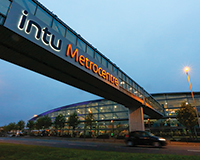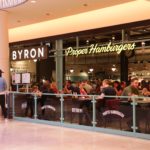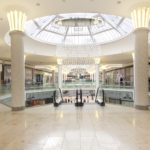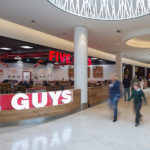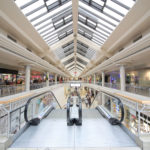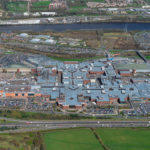As it celebrates its 30th anniversary, Gateshead’s intu Metrocentre remains the largest shopping centre in Europe. Claire Robson charts its history and asks what challenges lie ahead in the fast-moving world of retail
 The 2m sq ft intu Metrocentre is a centrepiece of the UK’s retail landscape and next month it will enter its fourth decade. As the UK’s first mega-mall, it set the trend for out-of-town shopping, but the changing face of retail means it has never had the luxury of resting on its laurels.
The 2m sq ft intu Metrocentre is a centrepiece of the UK’s retail landscape and next month it will enter its fourth decade. As the UK’s first mega-mall, it set the trend for out-of-town shopping, but the changing face of retail means it has never had the luxury of resting on its laurels.
Wind the clock back to the early 1980s and nobody would have believed that a coke-laden flood plain would be the site of a retail revolution. Yet one dogmatic developer had the bit between his teeth. Sir John Hall, a Northumberland miner’s son, had purchased a 120-acre ash dump in Dunston for around £100,000 and began to work his magic.
Metrocentre wasn’t always intended to be a shopping centre. Early plans involved a big shed development incorporating shops, industrial units and offices. Hall found it hard at first to win support for his vision until, inspired by visits to the US and Canada, he focused on out-of-town retail and got the attention of Marks & Spencer.
Once M&S had signed up for a 100,000 sq ft superstore, plans for a new style of shopping centre began to take shape.
Lambert Smith Hampton director Bill Lynn worked for Storey Sons & Parker at the time and was invited by Hall to show retailers around the site.
He says: “It was a largely derelict former power station. I brought along retailers to talk about his plans and they looked at me like I had lost my senses. But the M&S commitment helped it gain momentum and from then on there was no looking back.”
Against all odds, Hall persuaded a subsidiary of NatWest to help finance the project and later brought on board the Church Commissioners as a 50% partner. In 1981, the site became an Enterprise Zone with all the associated tax benefits, relaxation of planning requirements and rate-free status.
On 14 October 1986, the doors opened on a £150m mega-mall. Anchored by M&S at one end and a 120,000 sq ft Carrefour at the other, the centre attracted shoppers from far and wide.
Retired agent Eric Morgan was working on the other side of the river in Newcastle at the time. He says: “There were huge queues on the motorway, a brass band played and the whole thing went off with a bang. It was a massive achievement.”
Shoppers drove to the centre from Scotland, arrived on planes from Heathrow and ferries from Norway and Amsterdam.
Yet despite the initial fanfare, the centre continually had to adapt to maintain its status. The sheer volume of traffic demanded the development of multi-storey car parks, a new railway station and improved road connections.
In 1987, the year Hall sold his stake in the centre to the Church Commissioners for £272m, two new malls and a bus station opened, as did a UCI cinema. Hot on their heels was the arrival of Metroland, with its dodgems and rollercoasters, The Roman Forum and Mediterranean Village.
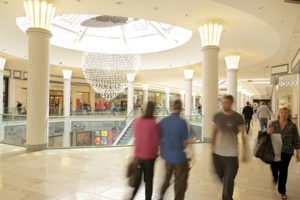
“It was seat-of-the-pants stuff,” says Bob Fletcher, director at intu Metrocentre agent @Retail. “It just kept getting bigger, gathering momentum like a rolling stone.”
After Capital Shopping Centres (now intu) acquired the mall for £364m in 1995, that rollercoaster ride continued.
In 2004, the new Red Mall was opened, incorporating retailers such as Debenhams and a public transport interchange. Five years later, following the closure of the indoor funfair, the new Yellow Mall (now the Qube) was unveiled, with new leisure facilities including bowling and the largest IMAX screen in the region.
In the past couple of years, intu has made further investment, upgrading its Platinum Mall to incorporate higher-end retailers such as Flannels and adding nine new restaurants to the Qube.
Today, intu Metrocentre has 342 shops – including the M&S and House of Fraser, which have been there throughout its long history. Some 21m people visit the centre’s five themed malls each year and occupancy currently stands at 93%. A headline rent of £300 per sq ft was set in 2006 and at the end of 2015, the scheme was valued at £952m, delivering intu an annual property income of £48.8m.
Recent lettings have been agreed with the likes of New Look Men, Pandora and Carluccio’s. According to @Retail, a further 12 units are currently in solicitors’ hands.
Intu’s regional director, Kate Grant, puts its longevity down to its adaptability. She says: “We have had to respond to ever-evolving retail requirements. Be it refurbishing malls, offering new configurations of units, or extending the leisure and catering offer, we have continued to meet new challenges.”
Future plans include focusing on high growth sectors such as childrenswear, beauty and jewelers, and also on the more experiential offer. Given the competition from online retail, intu is exploring a range of shopper experiences that can’t be enjoyed on the internet, from nail bars to personal shoppers.
In its quest to offer more than a shopping centre, intu is also assessing how it might use land surrounding the scheme. It has acquired the adjoining 16-acre former Federation Brewery site and is in consultation about delivering a large-format family attraction, along the lines of the Family Entertainment Centre it is developing with Nickelodeon at intu Lakeside in Essex.
Lambert Smith Hampton’s Lynn says: “To remain successful, they have to keep on top of the investment and ensure it’s constantly refreshed. If so, I see no reason why Metrocentre can’t maintain its place within the retail scene. I would be astonished if it falls from grace.”
Future-proofing
After 30 years in the spotlight, how is intu Metrocentre regarded by retail experts outside the North East and what is the key to its future survival?
According to CACI, intu Metrocentre currently sits at 34th in its overall retail rankings and 7th in its shopping centre rankings. It has performed fairly consistently over recent years, exploiting a wide catchment area and providing it with a comprehensive retail and leisure offer.
“Due to having a less affluent catchment, intu Metrocentre’s retail spend potential is below the likes of Bluewater in Kent, Meadowhall in Sheffield, and the Trafford Centre in Manchester,” says Jonathan De Mello, head of retail consultancy at Harper Dennis Hobbs.
“But with very little competition, it is a dominant regional draw. Intu cares a lot about tenant mix and is able to offer shoppers a huge spectrum, from value to high-end retail.”
De Mello says the main challenges will be continuing to expand the food offer and providing a one-stop entertainment experience to draw in the crowds.
James Findlater, head of shopping centres at Colliers International, agrees that intu has attracted a strong tenant mix and worked to improve its leisure offer, but says the centre is showing its age and will require attention.
He believes in the current retail environment as retailers look at the costs of opening new stores and with fewer multinational tenants looking for standard linear units it could push up vacancy levels. The centre’s Achilles heel is the plethora of small units and they need to be amalgamated to meet retailer requirements.”
As intu upgrades individual malls, it does give them an opportunity to combine smaller units to meet demand for bigger chunks of space. The centre also has areas where smaller units are let to local independents such as florists and opticians.
As at all shopping centres, the need to attract new tenants in a tough climate and keep occupancy levels high enough to secure rental growth will perhaps be the greatest challenge yet.







